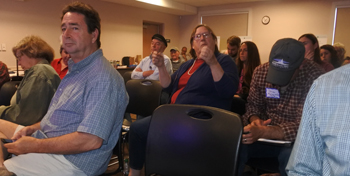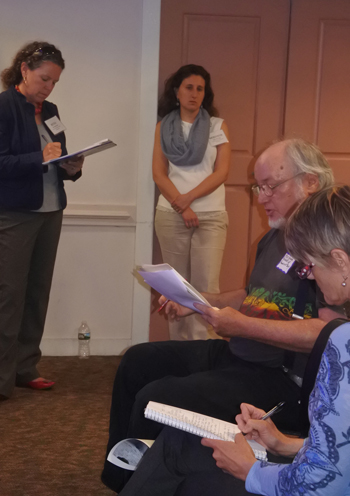First of Public Hearings Last Chance on Final Ocean Plan
by Steve Cartwright

Sonja Sleeper, center, of SouthThomaston said the plan ignores the impact on people’s lives. About 35 people, including the presenters, attended the meeting. Steve Cartwright photo
ROCKLAND, ME – June 6, 2016— Can government agencies work together for the good of the sea, the fishery, shipping, wind farms andpleasure boats?
Just such an attempt to bring cooperation and collaboration to myriad issues in the North Atlantic Ocean is being aired in Maine this month. It’s called the Northeast Ocean Plan, and it’s the first draft plan of a national project to coordinate the work of sometimes conflicting agencies and interests.
“Our ocean ecosystem is rapidly changing. I think we all realize that, whether it’s ocean acidification, changing sea temperatures,” said Betsy Nicholson, co-leader of the planning project and a Gloucester-based NOAA official. “There’s increasing concern among the public for the health and sustainability of our marine ecosystems.”
She called for a holistic view of ocean issues, from industrial to spiritual values. “What this plan really does is, it enables a more informed, proactive and inclusive decision-making process about our oceans, with ecosystem help right at the center,” she said. She envisions more transparency for the public, and more accountability from government.
On the other hand, Nicholson and others did not say what would happen if agencies refuse to cooperate, or break the hoped-for commitment. She acknowledged government has “not done so well” in the past. “A lot of this is based on frustration with the status quo.”
The ocean is home to traditional fishing and shipping, but new and expanding uses too, she said, including the first regional offshore wind farm being built off Block Island, and potential sand mining to restore eroded beaches as sea level rises.

Left: Ron Huber, reading right, representing Friends of Penobscot Bay, cited the vulnerability of the marine ecosystem and concern for the affects of chemical and other pollution alongshore. Betsy Nicholson, NROC, standing left. Steve Cartwright photo
Ron Huber, representing Friends of Penobscot Bay, cited the vulnerability of the marine ecosystem and concern for the affects of chemical and other pollution alongshore.
Sonja Sleeper of South Thomaston said the plan ignores the impact on people’s lives. “People in this area are being adversely affected by these regulations,” she said, noting limits on lobster traps.
Jim Barstow, longtime owner of Monhegan Boat Line, said in 1972 there were 60-70 boats fishing from Port Clyde, where there are now three working draggers. He said there are “181 bureaucrats making sure the fishing industry is on keel…look what we have lost in the last 25 years: hundreds and hundreds of jobs.”
Friendship lobsterman Richard Nelson, a perennial participant in public hearings and other forums, complained that a four-minute limit on comments was unfair. He said he wouldn’t have the time to adequately respond to the plan.
“I feel backed into a corner. I’ve given a lot of time and thought to this process and now here it is, 60 days (comment period) and I got to go fishing.”
He said the wording of the plan “sounds to me like a eulogy, a eulogy for fishing that’s now gone and is going to be replaced very soon by new ocean uses.” Sand mining, he said, “is not part of our conversation up here.”
About 35 people, including federal and state officials, attended this first-in-a-series public hearing in Rockland. Another hearing is set June 20 in Ellsworth, and a third June 30 in Portland. Comments may be submitted until July 25. For that and more information visit: neoceanplanning.org
The Northeast Ocean Plan stems from a 2010 Presidential Executive Order that, according to Nicholson, commits government at all levels to base decisions available scientific and other data, to identify conflicts and priorities. Six New England states, six federally recognized Native American tribes and nine federal agencies are involved, along with the New England Fishery Management Council.
